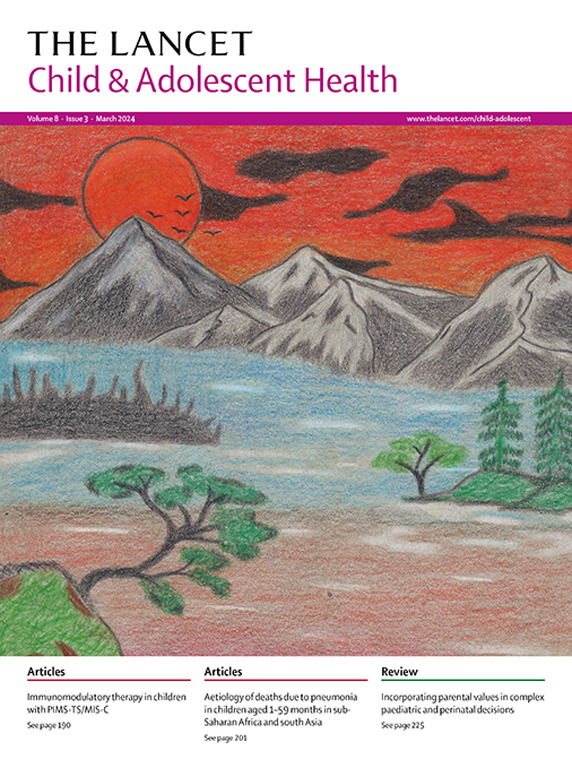西澳大利亚偏远地区控制儿童脓疱疮的三模式皮肤健康计划(SToP):分组随机阶梯试验。
IF 19.9
1区 医学
Q1 PEDIATRICS
引用次数: 0
摘要
背景:皮肤感染会影响身体健康,并通过耻辱化影响社会情感健康。如不及时治疗,可能会危及生命。我们旨在评估一项共同设计的全地区皮肤控制计划对脓疱疮发病率的影响:SToP(看、治、防皮肤溃疡和疥疮)试验是一项务实、开放队列、阶梯式分组随机试验,参与者年龄在 0-18 岁之间,分布在西澳大利亚州金伯利的九个偏远社区。试验涉及三个领域的计划干预:看(皮肤检查和皮肤感染识别培训)、治(皮肤感染治疗培训、治疗脓疱疮的磺胺甲噁唑-三甲氧苄啶和治疗疥疮的伊维菌素)和防(共同设计的健康促进和环境健康)。四个群组被定义为务实的社区集合体,分两步随机分配,在十次访问期间逐步接受活动。主要结果是患有脓疱疮的学龄儿童(5-9 岁)的比例。我们采用了意向治疗分析法,并将干预与对照(干预开始前的常规护理)状态进行了比较,利用贝叶斯模型得出了时间和群组平均效应。本研究已在澳大利亚新西兰临床试验注册中心(Australian New Zealand Clinical Trials Registry)注册,注册号为ACTRN12618000520235.研究结果:2018年9月19日至2022年11月22日期间,915名儿童获得同意,其中777名(85%)在2019年5月5日至2022年11月22日期间的10次可能就诊中至少一次进行了皮肤检查。在 777 名参与者中,有 448 人(58%)在一个或多个访问时间点时年龄为 5-9 岁,符合主要结果评估条件。所有群组的脓疱疮发病率均有所下降,在干预试验活动开始前的基线皮肤检查观察期间,发病率下降幅度最大。与对照期相比,干预期观察到脓疱疮的条件后几率平均值(95% 可信区间)为 1-13(0-71-1-70)。干预措施降低出现脓疱疮几率的概率为 0-33:在试验活动开始前的观察期,脓疱疮的发病率有所下降,但这一趋势在整个试验期间得以持续,这要归功于三模式皮肤健康倡议。虽然脓疱疮的发病率降低了,但没有直接证据表明这是试验活动的个别效果所致。包括皮肤检查在内的整体方法共同促成了脓疱疮发病率的持续下降:资金来源:西澳大利亚州卫生部、澳大利亚国家健康与医学研究委员会和Healthway。本文章由计算机程序翻译,如有差异,请以英文原文为准。
Trimodal skin health programme for childhood impetigo control in remote Western Australia (SToP): a cluster randomised, stepped-wedge trial
Background
Skin infections affect physical health and, through stigma, social-emotional health. When untreated, they can cause life-threatening conditions. We aimed to assess the effect of a holistic, co-designed, region-wide skin control programme on the prevalence of impetigo.
Methods
The SToP (See, Treat, and Prevent Skin Sores and Scabies) trial is a pragmatic, open-cohort, stepped-wedge cluster randomised trial involving participants aged 0–18 years in nine remote communities of the Kimberley, Western Australia. The trial involves programmatic interventions in three domains: See (skin checks and skin infection recognition training), Treat (skin infection treatment training, sulfamethoxazole–trimethoprim for impetigo, and ivermectin for scabies), and Prevent (co-designed health promotion and environmental health). Four clusters, defined as pragmatic aggregations of communities, were randomised in two steps to progressively receive the activities during ten visits. The primary outcome was the proportion of school-aged children (aged 5–9 years) with impetigo. We adopted an intention-to-treat analysis and compared the intervention with the control (usual care before the start of intervention) states to derive a time and cluster averaged effect using Bayesian modelling. This study is registered with Australian New Zealand Clinical Trials Registry, ACTRN12618000520235.
Findings
Between Sept 19, 2018, and Nov 22, 2022, 915 children were consented and 777 (85%) had skin checks performed on at least one of ten possible visits between May 5, 2019, and Nov 22, 2022. Of the participants, 448 (58%) of 777 were aged 5–9 years at one or more of the visit timepoints and were eligible for primary outcome assessment. A decline in impetigo occurred across all clusters, with the greatest decline during the observational period of baseline skin checks before commencement of the interventional trial activities activities. The mean (95% credible interval) for the conditional posterior odds ratio for observing impetigo in the intervention compared with the control period was 1·13 (0·71–1·70). The probability that the intervention reduced the odds of observing impetigo was 0·33.
Interpretation
A decreased prevalence of impetigo during the observational period before the commencement of trial activities was sustained across the trial, attributable to the trimodal skin health initiative. Although the prevalence of impetigo reduced, there is no direct evidence to attribute this to the individual effects of the trial activities. The wholistic approach inclusive of skin checks collectively contributed to the sustained reduction in impetigo.
Funding
Western Australia Department of Health, Australian National Health and Medical Research Council, and Healthway.
求助全文
通过发布文献求助,成功后即可免费获取论文全文。
去求助
来源期刊

Lancet Child & Adolescent Health
Psychology-Developmental and Educational Psychology
CiteScore
40.90
自引率
0.80%
发文量
381
期刊介绍:
The Lancet Child & Adolescent Health, an independent journal with a global perspective and strong clinical focus, presents influential original research, authoritative reviews, and insightful opinion pieces to promote the health of children from fetal development through young adulthood.
This journal invite submissions that will directly impact clinical practice or child health across the disciplines of general paediatrics, adolescent medicine, or child development, and across all paediatric subspecialties including (but not limited to) allergy and immunology, cardiology, critical care, endocrinology, fetal and neonatal medicine, gastroenterology, haematology, hepatology and nutrition, infectious diseases, neurology, oncology, psychiatry, respiratory medicine, and surgery.
Content includes articles, reviews, viewpoints, clinical pictures, comments, and correspondence, along with series and commissions aimed at driving positive change in clinical practice and health policy in child and adolescent health.
 求助内容:
求助内容: 应助结果提醒方式:
应助结果提醒方式:


